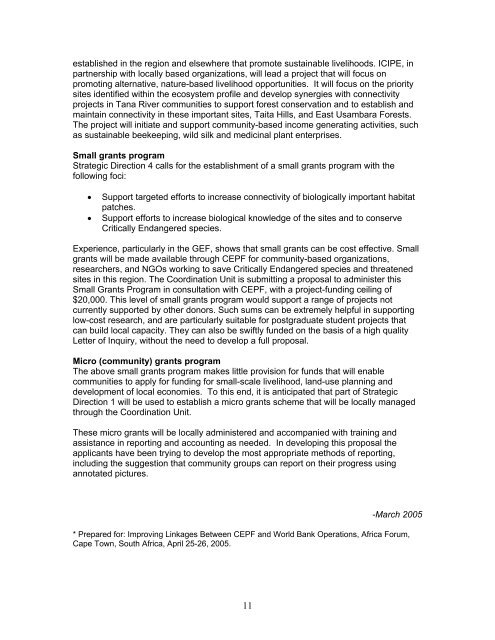Eastern Arc Mountains and Coastal Forests of Tanzania and Kenya ...
Eastern Arc Mountains and Coastal Forests of Tanzania and Kenya ...
Eastern Arc Mountains and Coastal Forests of Tanzania and Kenya ...
Create successful ePaper yourself
Turn your PDF publications into a flip-book with our unique Google optimized e-Paper software.
established in the region <strong>and</strong> elsewhere that promote sustainable livelihoods. ICIPE, inpartnership with locally based organizations, will lead a project that will focus onpromoting alternative, nature-based livelihood opportunities. It will focus on the prioritysites identified within the ecosystem pr<strong>of</strong>ile <strong>and</strong> develop synergies with connectivityprojects in Tana River communities to support forest conservation <strong>and</strong> to establish <strong>and</strong>maintain connectivity in these important sites, Taita Hills, <strong>and</strong> East Usambara <strong>Forests</strong>.The project will initiate <strong>and</strong> support community-based income generating activities, suchas sustainable beekeeping, wild silk <strong>and</strong> medicinal plant enterprises.Small grants programStrategic Direction 4 calls for the establishment <strong>of</strong> a small grants program with thefollowing foci:• Support targeted efforts to increase connectivity <strong>of</strong> biologically important habitatpatches.• Support efforts to increase biological knowledge <strong>of</strong> the sites <strong>and</strong> to conserveCritically Endangered species.Experience, particularly in the GEF, shows that small grants can be cost effective. Smallgrants will be made available through CEPF for community-based organizations,researchers, <strong>and</strong> NGOs working to save Critically Endangered species <strong>and</strong> threatenedsites in this region. The Coordination Unit is submitting a proposal to administer thisSmall Grants Program in consultation with CEPF, with a project-funding ceiling <strong>of</strong>$20,000. This level <strong>of</strong> small grants program would support a range <strong>of</strong> projects notcurrently supported by other donors. Such sums can be extremely helpful in supportinglow-cost research, <strong>and</strong> are particularly suitable for postgraduate student projects thatcan build local capacity. They can also be swiftly funded on the basis <strong>of</strong> a high qualityLetter <strong>of</strong> Inquiry, without the need to develop a full proposal.Micro (community) grants programThe above small grants program makes little provision for funds that will enablecommunities to apply for funding for small-scale livelihood, l<strong>and</strong>-use planning <strong>and</strong>development <strong>of</strong> local economies. To this end, it is anticipated that part <strong>of</strong> StrategicDirection 1 will be used to establish a micro grants scheme that will be locally managedthrough the Coordination Unit.These micro grants will be locally administered <strong>and</strong> accompanied with training <strong>and</strong>assistance in reporting <strong>and</strong> accounting as needed. In developing this proposal theapplicants have been trying to develop the most appropriate methods <strong>of</strong> reporting,including the suggestion that community groups can report on their progress usingannotated pictures.-March 2005* Prepared for: Improving Linkages Between CEPF <strong>and</strong> World Bank Operations, Africa Forum,Cape Town, South Africa, April 25-26, 2005.11
















